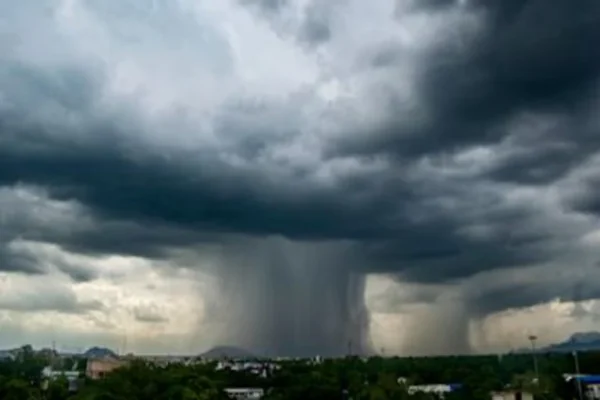
What Is A Cloudburst And Why Does It Happen?
One of the most naturally dangerous weather events is cloudbursts. They can cause very damage in a short time and happen suddenly and without much notice. A cloudburst,unlike normal rainfall, its so powerful that the ground & rivers are unable to absorb the amount of water, which often results in landslides and flash floods.
In this blog, we will explore what a cloudburst is, why it happens and how long it lasts, and how it is different from heavy rain.
What is a Cloudburst?
A cloudburst is a sudden and intense rainfall that occurs in a very short time, usually within an hour and often with little warning. In contrast to regular rain, a cloudburst is so powerful that it can drop several centimeters of rain in just minutes, causing rivers and streams to overflow. This sudden downpour often results in flash floods, landslides, and severe damage to both the environment and communities.
Cloudbursts are most common where warm air from the plains meets cold air from the hills, creating conditions for torrential rainfall in mountainous areas like the Himalayas.
Why Do Cloudbursts Happen?

Cloudbursts happen due to a combination of weather conditions and geography. While the science behind them may seem complicated, it’s actually pretty simple to understand:
Cloudbursts usually happen following causes:
1. Moist Air Rising Up:
When warm, moist air rises from the plains to higher altitudes, it quickly cools in the upper atmosphere. This cooling turns the invisible water vapor into tiny droplets. These droplets keep joining together and form very thick and heavy rain clouds. The process happens so fast that the clouds grow much faster than usual.
2. Clouds Trapped in Mountains:
In mountainous or hilly areas, clouds often get trapped because tall peaks block their movement. Instead of spreading out, they stay in one place and continue to absorb more moisture. This “trapping effect” makes the clouds denser and heavier, holding more water than usual.
3. Clouds Becoming Overloaded:
As the clouds rise higher into the cold atmosphere, the temperature drops even more. The water droplets inside them multiply so quickly that the cloud becomes overloaded. Once it reaches this point, the cloud can’t hold the water any longer, making it unstable and dangerous.
4. Thunderstorms and Winds:
Thunderstorms are connected to cloudbursts. Clouds may become unsteady due to strong winds & unstable air pressure. It could force them to all release water immediately.
5. Sudden Release of Water:
Once the cloud is unable to hold the extra weight, it bursts open and releases a huge amount of rain in a very short time. Instead of falling gradually, all the stored water comes down at once. This extreme downpour over a small area is what we know as a cloudburst, often leading to flash floods and landslides.
How Long Do Cloudbursts Last?
Cloudbursts are very short-lived but extremely intense. Most cloudbursts usually last anywhere between 10 to 30 minutes, though in rare cases they can continue for almost an hour. What makes them so dangerous is not the duration but the amount of rain they release in such a short time.
In just 15 to 20 minutes, a cloudburst can dump as much water as a city usually gets in several days of rain. Because the rain comes so suddenly and in such a small area, the ground and rivers can’t absorb or carry the water quickly enough. This causes cloudbursts to trigger flash floods, mudslides, and landslides within minutes of the downpour.
For Example:
An area may receive 50 to 100 mm of rain in 15 to 30 minutes during a cloudburst. Cause there isn’t enough time for this huge amount of water to properly drain away or sink into the ground, flooding occurs so quickly.
The damage caused is long-lasting even though it is temporary. Houses, farms, bridges & roads can all be wiped away in a matter of minutes.
What is the Difference Between a Cloudburst and Heavy Rain?
Although their similar sounds cloudbursts & heavy rain are not the same thing:
Heavy rain is spread out over a long period, while a cloudburst is short, intense, and highly concentrated. A cloudburst, on the other hand, is sudden, very intense rainfall in a small area, usually within 10–30 minutes.
1. Time Duration:
. Heavy rain: Can last for several hours or even days.
. Cloudburst: The following may last anywhere from a few minutes to an hour or so.
2. Rainfall Intensity:
. Heavy rain: it is constant long long-lasting heavy rain.
. Cloudburst: Extremely intense rainfall that falls all at once.
3. Area Covered:
. Heavy rain typically covers a wide area.
. Cloud burst: it affects a very small and localized area.
4. Impact:
. Heavy rain: it causes waterlogging, swollen rivers, or gradual flooding.
. Cloudburst: Causes sudden flash floods, landslides & immediate destruction.
To put it simply, while cloudbursts occur suddenly and leave no time to react, heavy rain allows time to prepare and control the water.
How Can Cloudbursts Affect Our Safety?
The variability of storms makes it hard to assess their exact moment, but safety precautions can lower risks:
1. Weather Warning:
Make sure to pay extra attention to climate predictions during the monsoon season, especially for hilly areas or regions at risk of flooding.
2. Avoid Risky Area:
Avoid wet hills, unstable slopes or riverbanks while it’s raining a lot.
3. Emergency Plans:
In the event of unexpected flooding, populations in hilly areas should have evacuation plans.
4. Infrastructure Planning:
In regions prone to cloud bursts, governments must construct better drainage systems and flood barriers.
A cloudburst is a sudden, powerful, and dangerous rainfall that typically occurs in mountainous regions. It occurs when moist air rapidly rises, cools, and releases large amounts of water in a short period. Although it doesn’t last long, it causes significant destruction.
The main difference between a cloudburst & heavy rain is intensity & speed. Heavy rain is spread out over a longer period, while a cloudburst is brief, intense, and highly concentrated.
A cloudburst is a sudden, intense rainfall that can trigger flash floods and landslides within minutes. Unlike heavy rain, it focuses on a small area and is much more destructive. Understanding cloudbursts helps us stay prepared and protect vulnerable regions worldwide.
Q1. Is a cloudburst the same as heavy rain?
Ans. No, heavy rain lasts longer and covers a wide area, while a cloudburst is short, sudden, and extremely powerful, often leading to flash floods.
Q2. How long does a cloudburst usually last?
Ans. Cloudbursts are short-lived but intense. They generally last from 15 minutes to one hour, but in that time they can pour as much rain as a city normally gets in weeks, leading to flash floods.
Q3. Can cloudbursts be predicted?
Ans. Meteorologists use radar and satellite systems to track extreme rainfall, but predicting the exact timing and location of a cloudburst is still very difficult. Warnings are often issued only for high-risk regions.
Q4. Where do cloudbursts mostly occur?
Ans. They are most common in hilly and mountainous areas, especially in the Himalayas of India, Pakistan, and Nepal, during the monsoon season.
Read more related articles > https://www.climatechallange.com/severe-thunderstorms-warnings-across-u-s-midwest/